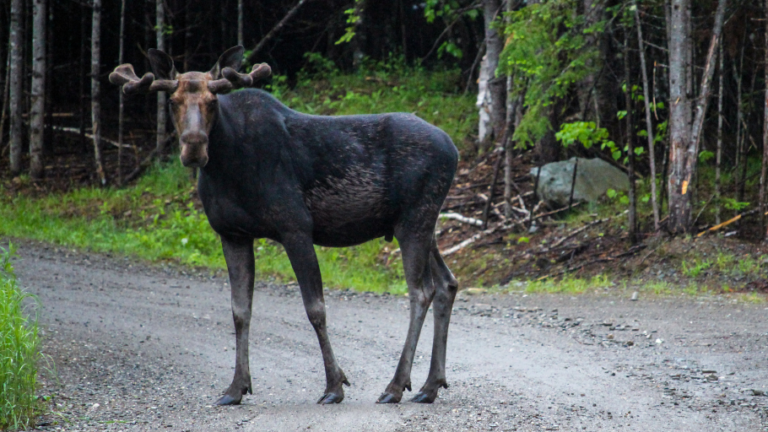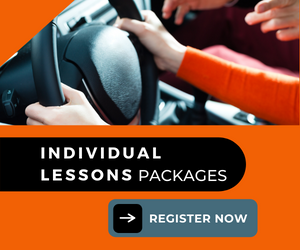Hints for the Highway
What Can Drivers Do:
- To reduce the chances of having a wildlife-vehicle collision?
- If they encounter wildlife on the road?
- If a crash is inevitable?
How Can Drivers Reduce the Chances of Having a Wildlife Vehicle Collision?
Watch for the Signs
What do those signs really mean?
A Wildlife Warning Sign is a yellow diamond-shaped sign. The sign warns of a hazard ahead and advises drivers to be cautious. The sign does not require drivers to slow down to a particular speed unless there is an adjacent speed limit sign posted as well.
Drivers must obey wildlife warning signs and any associated speed changes. The signs are located in high wildlife use areas. Drivers must not disregard the signs even if they have been seen many times before. Driver complacency is dangerous.
Speed is one of the most common factors in vehicle collisions. Speed:
- Reduces the driver’s ability to steer away from objects in the roadway
- Extends the distance required to stop
- Increases the force of impact, in the event of a collision
With good road conditions, drivers tend to increase their speed. Some studies suggest that wildlife-vehicle collisions occur more than expected on clear nights, on dry road conditions, and on long straight stretches. Drivers may tend to be more cautious on curves or in poor weather
By maintaining the posted speed, drivers can compensate for increased risk.
Think “What If…?”
- Mental preparation is a useful tool.
- Think about and predict what you might do if an animal suddenly darted out in front of you or ran towards your vehicle.
- It is better to think about and learn how to avoid an encounter with wildlife than have to react to a dangerous situation when you are unprepared.
Drive Defensively
Drivers and passengers should actively watch for:
- wildlife – on the road, in the ditch, on the shoulder, and in the right of way
- movement on or alongside the road
- shining eyes, which will be your headlights reflecting off the animal’s eyes. NOTE: Moose are so tall that their eyes are normally above the beams of most vehicle headlights, and so are less likely to reflect the light
- Flickering headlights of oncoming cars or tail lights of the vehicles in front of you – which may be an animal crossing the road
- Roadside reflectors that disappear/reappear, which might indicate an animal crossing in front of them Watch out between dusk and dawn. Light levels are low, and animals are active.
Anecdotally, there seems to be some evidence that animals that approach from the right side are avoided more successfully than animals that approach from the left, as drivers’ headlights illuminate that portion of the road better, and drivers pay close attention to the right-hand side of the road and the ditch – so remember to pay equal attention to both the right and left-hand sides of the road.
Think about the landscape that you are driving through. Is it a good habitat for wildlife? Studies show that problem locations are where creeks intersect roads, areas where there is good roadside habitat nearby, and long straight stretches (because people tend to speed up).
If smaller animals such as deer are in your way – think carefully. Is it safe to swerve?
Do not take unsafe evasive actions. Serious accidents can occur when drivers lose control of their vehicles trying to avoid an animal. Always reduce your speed in signed areas. Driving at a slower speed may mean it is not necessary to swerve at all. Swerving can take you into the path of an oncoming vehicle or into the ditch.
If a deer is in your way, consider using your brakes, not your wheel.
If you have to choose between swerving or striking a moose, consider swerving. A collision with a moose, which can weigh up to 500 kgs (1200 lbs), carries a significant risk of injury or death to motorists and passengers. If a crash with a moose is inevitable, crouch as low as possible in your seat, or under the dash, as a moose’s body usually ends up crushing the roof of a car completely flat.
Use Your Vehicle
- Maintain your vehicle – Keep head lights, signal lights, and tail lights clean and in good working order.
- Clean your windshield, inside and out, once a week, or more if someone smokes, and check and repair windshield wiper blades.
- Keep headlights properly aligned to avoid blinding other drivers and optimize road coverage. Keep your headlights clear of dirt and road salt residue. Check the condition of the headlight lenses in the spring and fall and clean, repair or replace if they are cloudy or scratched.
- Wear your seatbelt at all times.
- Honk your horn or flash your lights to scare animals off the road. This may scare a deer off the road, but does not usually work for moose.
- In a 3 lane situation, when it is safe to do so, and when it is not impeding other traffic, drive in the middle lane to provide more distance from the ditch.
- Use high beams when it is safe to do so, and scan the road ahead with quick glances.
- At night, use the high beams of the vehicle in front of you to extend your effective sight distance.
- Install enhanced headlights to extend your effective sight distance – but do not exceed federal guidelines
- Investigate an “Electronic Stability Control” system for your vehicle
What Should Drivers do if They See Wildlife on the Road?
- Slow Down – collision avoidance and driver response time are improved at slower speeds
- Anticipate unpredictable behavior from all wildlife
- Determine what the animal is doing and where it is going
- Some animals travel in groups – where there is one animal, there may be more. Watch for doe/fawn or moose cow/calf pairs.
More detailed information on animal behavior is found on The Wildlife Factor page. Please have a look there.
What if a Crash is Inevitable?
In certain conditions, there is no real choice except to strike the animal.
If it appears impossible to avoid the animal:
- Aim for the spot the animal is coming from, not where it is going.
- Look where you want to go, not at the animal. You tend to drive where you look – if you are looking at the animal, that is where the vehicle tends to go.
- If you must hit something, try for a glancing blow rather than a head-on hit.
- Brake firmly and quickly, then look, and steer your vehicle to strike the animal at an angle.
- Let up on the brake just before you hit the animal. This causes the front end of your vehicle to rise and reduces the chances of the animal coming through your windshield.





